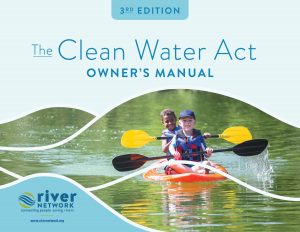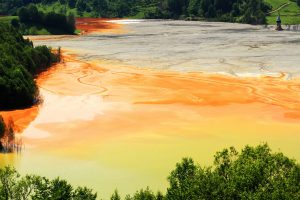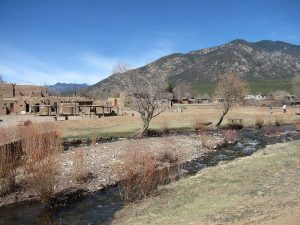The Clean Water Act
The Clean Water Act (CWA) is one of the most comprehensive environmental statutes in the United States. It seeks to protect both human health and ecological resources, to maintain healthy waters, and to restore waters that are impaired. The CWA provides states and authorized tribes with the tools and guidance necessary to protect and maintain healthy waterways in cooperation with federal government agencies.
The CWA’s overarching objective is to “restore and maintain the chemical, physical, and biological integrity of the Nation’s water,” with the goals of eliminating pollutant discharges and providing for the “protection and propagation of fish, shellfish, and wildlife” and “recreation in and on the water.” CWA, Section (101(a))
As public participation throughout the CWA process is essential to achieving these goals, River Network is pleased to provide this page, with resources on key CWA components:
Clean Water Act 101

The 3rd Edition of the Owner’s Manual was released on October 18, 2022.
- The Clean Water Act Owner’s Manual: River Network first developed this user-friendly guide to the foundational programs of the Clean Water Act in 1999. The Owner’s Manual was updated in 2005 and is available to download for free.
- Which waters are protected under the CWA? There are longstanding battles over the scope of the CWA and which waters are covered under the law’s jurisdiction. In early 2020, the Trump Administration finalized the “Navigable Waters Protection Rule,” which reduced protections for a significant amount of small streams and wetlands. Read more about this Dirty Water Rule on River Network’s blog.
- Get to know this landmark US water policy, in the video below, produced in collaboration with Resource Media. It provides an overview of the history and contents of the Act including designated uses, water quality criteria, and antidegradation (as well as what all that means!). It’s a great primer for community scientists, monitoring program staff, or anyone else interested in Clean Water Act policy and advocacy.
Water Quality Standards
Water quality standards lay the building blocks to protect and restore our rivers, lakes, and wetlands. The US Environmental Protection Agency (EPA) requires each state and authorized tribe to establish designated uses, water quality criteria to protect those uses, and antidegradation planning to keep clean waters clean and to protect existing uses. Collectively, these three elements make up water quality standards.
- Water Quality Standards 101: This beginner-level webinar explains the nuts and bolts of water quality standards.
- “What Are Water Quality Standards?” This EPA website features a breakdown of the different water quality standard components.
- The Clean Water Act Through a Biological Lens: One of the CWA’s goals is to protect “biological integrity.” This River Network webinar explains what that means and how it is applied.
- Tracking TMDLs: A Field Guide for Evaluating Proposed Watershed Restoration Plans: A guide from River Network and the National Wildlife Foundation explaining the Total Maximum Daily Load (TMDL) provision (found in Section 303(d) of the CWA), a powerful watershed restoration tool that combats all sources of pollution, including diffuse sources.
Water Quality Certification
Section 401 is a powerful tool for states and tribes to protect clean water (and sometimes flows!) from federally permitted activities.
- Water Quality Certification 101: In this beginner-level webinar, viewers learn the basics of how to use Section 401.
- Using Water Quality Criteria on Nationwide Permits: An intermediate-level webinar on how to use Section 401 to protect wetlands.
- Water Quality Certification Case Studies: This intermediate-level webinar details case studies from around the country, presented to illustrate the use of Section 401.
Point Source Pollution and Permits
 Point sources of pollution such as wastewater treatment plants, industrial facilities, concentrated animal feeding operations, and stormwater systems, are regulated under the CWA’s National Pollution Discharge Elimination System (NPDES) program. Learn more about how this important program works.
Point sources of pollution such as wastewater treatment plants, industrial facilities, concentrated animal feeding operations, and stormwater systems, are regulated under the CWA’s National Pollution Discharge Elimination System (NPDES) program. Learn more about how this important program works.
- Point Source Pollution Permits 101: This beginner-level webinar covers the basics of permitting, how to review permits, and where to find further resources.
- Stormwater Discharge Permits: Municipal stormwater controls fall under the CWA’s permitting system. This intermediate-level webinar explains the municipal permitting system, what’s required, and how to review them.
- “Managing Urban Runoff”: This page discusses urban runoff as a source of pollution into our waterways, and includes links to management and permitting options.
- Permitting an End to Pollution: How to Scrutinize and Strengthen Water Pollution Permits in Your State: This handbook is designed to help citizens influence the issuance of NPDES permits.
Tribal Roles in Implementing the Clean Water Act

Rio Pueblo de Taos, New Mexico. River Network worked with Taos Pueblo Environment Department staff on CWA protections. Photo by John Phelan (CC BY 3.0).
Tribes can seek authorization with the EPA to implement the Clean Water Act programs, including water quality standards, water quality certifications, NPDES and dredge and fill permitting, and listing of impaired waters.
- Tribal Roles in Clean Water Act Implementation: This beginner-level session provides an introduction to the Clean Water Act and the roles tribes play in its implementation.
Engagement Opportunities: How YOU Can Get Involved!
There are always opportunities for the public to become involved in the CWA process through public comment opportunities, data submission, and public hearings. Head to your state’s environmental department website and sign up for their notification system or bookmark their public engagement pages and check in often. Engagement opportunities are available through the Integrated Report, Triennial Review, and permitting.
The EPA requires states and authorized tribes to report on impairments (303(d) list) and status (305(b) list) of their waters (collectively known as the Integrated Report) every two years, and to review and revise (if necessary) their water quality standards (known as the Triennial Review) every three years. These processes are required to solicit public input and they present great opportunities for you to share your local knowledge and data with your state. Sign up for your state’s listserv or notification system so you are aware of when these reports are open for public review and comment. You can also inquire about submitting your data to be incorporated into the Integrated Report. Permits will also have opportunities for public input for new permits and for renewals, so keep tabs on the permits in your area and keep an eye out for renewals! Interested in reviewing and commenting on your state’s integrated report? Check out this guidance document to get started.
The Clean Water Act Owner’s Manual highlights and explains these opportunities for public engagement.
River Network and the Coalition for the Delaware River Watershed have created a webpage to help inform the groups in the Delaware Basin of open opportunities. You can do the same in your watershed to encourage the public to share their knowledge!
Additional Resources & Press
- The Clean Water For All Coalition has a number of materials and fact sheets on the Clean Water Rule and the Dirty Water Rule.
- Read River Network President Nicole Silk’s op-ed in the Progressive
- Read Joe Mallory’s (Cincinnati NAACP) op-ed for Cincinnati.com
- Read Gayle Killam’s reflections on her two decades of Clean Water Act work with River Network
- Read Colleen Walters’s blog post on the Clean Water Act in 2020
- An Artificial Distinction: Tools for Addressing Low Flow Problems Under the CWA, River Network webinar (2011)
- An Artificial Distinction: Addressing Water Quantity Concerns Under the Clean Water Act, River Network paper (2011)




